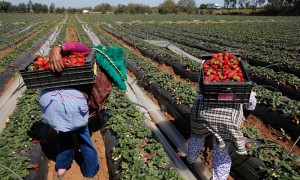The Guardian
Celeste Hicks in Casablanca
Farmers in the Moroccan town of Moulay Bousselham, Kénitra province, pick strawberries for export. Morocco’s nationwide agriculture plan has boosted production.
Morocco’s progress on reducing poverty and eliminating hunger through a nationwide plan has received qualified praise from the UN special rapporteur on the right to food.
Hilal Elver acknowledged the country’s achievements in boosting production through “plan Maroc vert” (plan for a green Morocco, or PMV), but cautioned that more needed to be done to reach small-scale farmers in outlying areas.
“Morocco’s green plan … should be implemented equally across the regions through effective consultation with local populations and improved coordination of services,” said Elver after a week-long visit.
Morocco launched the PMV in 2008, with the ambition to promote socio-economic development through agriculture. It has two main pillars: maximising production from modern large-scale farms through the promotion of agribusiness and investment, and reducing poverty and hunger through the support of small-scale farmers in marginal areas.
Agriculture accounts for 15% of Morocco’s GDP but is even more important to job creation. Up to 40% of the population works in the sector.
The figures for large-scale productionare impressive. Since 2008, at least 150bn dirhams (£10bn) has been invested in approximately 700 “pillar one” projects such as mechanisation, irrigation and the use of fertilisers.
Several banks and international agencies have invested – including the African Development Bank, which has pledged $132m (£86m) to support the PMV – and private agricultural investment companies have also been keen to take advantage of Morocco’s potential to export fruit and vegetables to Europe.
The UN’s Food and Agriculture Organisation (FAO) estimates that the agricultural sector has grown by roughly 7% a year since 2008. Exports have risen by 34%, 11% more farmland is now in use, and ambitious targets have already been met, for example to increase red meat production to 500,000 tons a year by 2020.
There has also been investment in “pillar two” projects, but to a lesser degree. According to ministry of economy figures, 15-20bn dirhams has been spent since 2008 on about 550 small-scale projects, such as helping farmers to diversify their businesses, increase yields and try new seed varieties. Again, the results are impressive. Only 4.6% of people in rural areas were classed by the FAO as malnourished in 2015, compared with 7.1% in 1990, and Morocco met the millennium development goal on halving extreme poverty and hunger two years before the deadline.
“The plan Maroc vert has created an irreversible momentum without precedent,” says Michael George Hage, an FAO representative in Morocco. “It has played a determining role in food security and is inspiring several other African countries.”
Nevertheless, there have been criticisms that the PMV has focused too heavily on large-scale production, putting the interests of agribusiness aimed at export ahead of the needs of poor farmers in rural areas.
During her visit, the special rapporteur met a number of farmers and women’s cooperatives in outlying regions such as Midelt, Ouarzazate and Errachidia. “Infrastructure should be improved in remote areas to ensure easy access to markets, and to attract investment to rural areas, while projects that target women and young farmers should be encouraged further,” she said after the visit.
Identifying how young people can be encouraged to take up the profession is key. “People think farming is dirty and low-skilled,” said Mustapha Alkhaouli, who runs a beef and mutton farm on the outskirts of Casablanca. “My friends don’t understand why I want to do it, and in fact I also have to run a business in the city to make enough money. But farming is in my blood, I picked up what I know from my father and I want to continue to learn.”
The FAO has pointed out that gaps remain in the provision of technical assistance to small-scale farmers and that finance is often difficult to obtain. With an adult illiteracy rate still stubbornly high at more than 30%, female farmers in particular can struggle to gain official support.
A number of programmes have been launched to train farmers, such as those run by the Casablanca chamber of agriculture to encourage local pastoralists to move into the production of mozzarella and goat cheese. But trainers say they often encounter hostile attitudes.
“Older farmers don’t want advice,” said one. “They don’t want young people trying to tell them how to change something they’ve done for their whole life.”
Morocco’s PMV aims to reach its objectives by 2020 and, although few independent analyses of the data have been carried out, it appears most targets will be met.
Problems remain, however. The continuing reliance on a good rainy season for a successful harvest raises questions about how Morocco will cope with the effects of climate change. Moreover, the country has so far been unable to break its dependence on imported cereal (2.8 million tons in 2015-16), which makes it vulnerable to volatility in world markets.
Elver said during her visit that more needed to be done to protect biodiversity and scarce water resources as large-scale agricultural production intensified.








